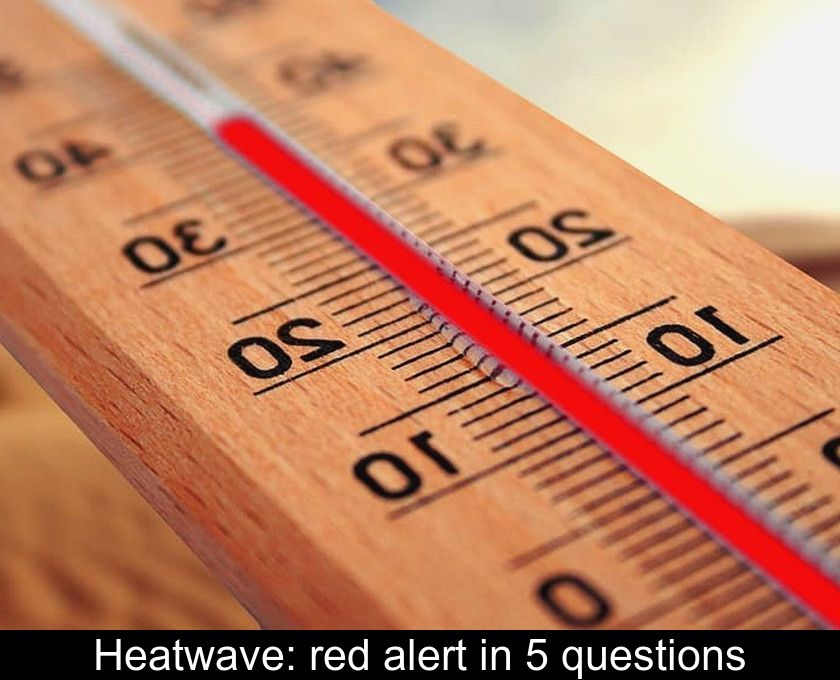Heatwave: Red Alert In 5 Questions
On August 23, 2023, 19 departments in France have been placed under red heatwave alert by Météo-France. This highest level of alert concerns an area stretching diagonally from Gers to Ain. But do you know what this color actually means for the affected departments? Here's a summary to understand everything about red alert in 5 questions.
How is the color of the heatwave alert determined?
While a late heatwave is affecting most of our country, you may be surprised to see on the weather report that some departments are changing from orange heatwave alert to red heatwave alert, or vice versa, from red to orange.
The heatwave alert system has been in place in France since 2004. It was implemented after the major heatwave of 2003, which resulted in nearly 15,000 deaths in the country. It consists of three levels of alert indicated by the colors yellow, orange, and red.
To determine the color and level of alert for each area, Météo France relies on a set of criteria previously defined by health authorities for each department, based on epidemiological studies and observed health impacts during previous episodes of high temperatures.
In practice, to assess the level of heatwave alert, Météo France's forecasters compare their weather forecasts with reference values established by Santé Publique France.
When deciding on the color for a department, they also take into account certain aggravating factors (such as the duration of the heatwave, pollution, or air humidity) or mitigating factors (such as the brevity of the heatwave episode).
2- What does the red alert level mean?
The different levels of weather alert are intended to alert the population to the level of vigilance they should adopt regarding a meteorological phenomenon, in this case, heatwave.
The red heatwave alert is the highest level of alert. Since the creation of the heatwave plan in 2004, it has only been triggered 6 times in total.
The color red means that the population must exercise absolute vigilance because an exceptionally intense meteorological phenomenon is expected. In this specific case, it signals an extreme heatwave, exceptional in its duration, intensity, or geographical extent.
This level of vigilance also means that the phenomenon has a strong health and social impact for the entire population, requiring maximum mobilization of all stakeholders (prefecture, local authorities, etc.).
3- What actions are taken in case of a red heatwave alert?
As soon as a heatwave episode is forecasted by Météo France for 3 consecutive days and nights, specific actions are triggered by the prefects of the departments. When the red heatwave alert is confirmed, the prefects of the concerned departments can make exceptional decisions to protect the population.
For example, the prefect can prohibit or limit the scale of certain outdoor events such as cultural festivals or sports competitions.
They can also give instructions to public establishments such as nurseries, leisure centers, or holiday centers... These places may be forced to cancel outings, outdoor events, or sports activities. They may even have to close if the temperature inside their premises is too high.
4- What are the employer's obligations in case of a red heatwave alert?
When the heatwave red alert is triggered, companies must comply with certain obligations to protect the health of their employees.
In certain professional sectors, organizations are put under strain by extreme temperatures, which increases the risk of workplace accidents. That is why, in case of a red alert, work inspection controls are reinforced in outdoor professions such as construction and agricultural work, as well as in the restaurant, bakery, and dry-cleaning sectors where workers are particularly exposed to extreme heat.
As a reminder, the Labor Code requires employers to adapt "work organization to weather conditions" as much as possible to ensure the physical and mental health and safety of employees.
Furthermore, in case of a red alert, additional obligations apply to the employer. They must carry out a daily reassessment of the risks involved, taking into account the age and health status of each employee.
The Ministry of Economy emphasizes that "workload, schedules, and, more generally, work organization must be adjusted" according to the current weather conditions. It also specifies that teleworking should be prioritized for pregnant women and individuals with chronic illnesses or disabilities.
If the measures taken prove to be insufficient because the work is carried out at a very high temperature or involves significant physical exertion, "the employer must decide to stop the activity" according to the Ministry of Labor. In case of an orange or red alert, compensation or recovery of lost hours due to heatwave is possible.
Note: If your employer does not comply with these obligations, you can contact the labor inspection services, the social and economic committee of your company, or the employee representative. Furthermore, if you believe that your working conditions pose a serious and imminent danger to your life or health, you can exercise your right to withdraw in accordance with Article L4131-1 of the Labor Code.
5- What actions should be taken in case of a red alert?
The good reflexes to adopt in case of red heatwave alert are the same as for orange alert, namely:
- drink plenty of water
- avoid physical exertion
- wet your body
- ventilate your home at night
- frequent cool places during the day.
However, there is a difference to remember between these two levels of alert. When the heatwave alert changes from orange to red, these different advice apply to everyone, even to healthy individuals, and not only to the elderly or at-risk individuals.





